Multiclassification Method of Landslide Risk Assessment in Consideration of Disaster Levels: A Case Study of Xianyang City, Shaanxi Province
Abstract
:1. Introduction
- (1)
- Nine evaluation factors are selected from the four aspects of terrain features, meteorological features, human influence, and historical geological disasters to construct the landslide hazard evaluation index system: elevation, slope, aspect, normalized difference vegetation index (NDVI), distance from rivers, accumulated rainfall, distance from roads, lithology, and landforms. Using the idea of multiclassification, a landslide hazard assessment model based on a multiclass SVM is proposed. This method selects multitype samples according to the scale of divided multilevel landslide hazards, improves the sample types of landslide classification and is beneficial to the hazard assessment of multilevel landslide disasters.
- (2)
- Four evaluation factors for landslide vulnerability are selected from the three aspects of population vulnerability, economic vulnerability, and material vulnerability to construct a landslide vulnerability evaluation index system: population density, arable land density, GDP density, and road density. Combining the AHP and the entropy method, a landslide vulnerability assessment model that considers the subjective and objective weights is proposed. This paper evaluates the vulnerability of landslides by combining subjective and objective weighting calculation methods, combines the advantages of subjective and objective methods, and avoids the objective limitations caused by a single weighting method.
- (3)
- Taking the landslide in Xianyang city of Shaanxi Province as the research object and taking the towns as the evaluation unit, the landslide risk assessment is carried out based on the landslide hazard assessment model and the landslide vulnerability assessment model. This paper generates the landslide risk assessment zoning map of the study area, analyzes the results by using the existing risk levels of landslide points, summarizes the risk characteristics of landslides in various towns, and provides a scientific basis for the implementation of regional disaster prevention and mitigation.
2. Research Area and Data
2.1. Research Area
2.2. Data
3. Landslide Risk Assessment Method
3.1. Classification of Geological Disaster Scale
3.2. Landslide Hazard Assessment Model Based on Multiclass SVM
3.2.1. Multiclass SVM
3.2.2. Algorithm Flow
- (1)
- Construction of the landslide hazard assessment index: nine index factors were selected from three aspects to construct the landslide hazard assessment index system in the study area.
- (2)
- Construction of the sample dataset: units with the same number of landslide hazard points were randomly selected as nongeological hazard units, and the two were combined as the sample dataset.
- (3)
- Sample point classification: according to the classification standard of the landslide disaster scale, the landslide hazard sample points in the study area were classified by hazard level, and 80% of all samples were selected as the training sample and 20% as the test sample.
- (4)
- Parameter optimization: the radial basis function was selected for multiclassification of nonlinear samples, and the optimal parameters c and g were selected by the cross-validation method.
- (5)
- Landslide hazard zoning map: the natural discontinuity method was used to divide landslide hazard grades into four categories.
3.3. Landslide Vulnerability Assessment Model Considering Subjective and Objective Weights
3.3.1. Combined Weights
- (1)
- Subjective weighting method
- (2)
- Objective weighting method
- (3)
- Combined weights
3.3.2. Algorithm Flow
4. Experiment and Analysis
4.1. Classification of Geological Disaster Types and Levels in the Study Area
4.2. Landslide Hazard Assessment Based on Multiclass SVM
4.3. Landslide Vulnerability Assessment Considering Subjective and Objective Weights
4.4. Landslide Risk Assessment
- (1)
- Lower-risk areas were mainly distributed in Changwu County, Binzhou City, Xunyi County, Yongshou County, Chunhua County, Liquan County, etc. There were three landslide disaster points in this area, accounting for 1.40% of the total landslide disaster points. There were few geological disasters in this area, a low density of disaster points, and low landslide risk. In addition, the area had low urbanization, sparse population, low economic development, and low landslide risk.
- (2)
- Low-risk areas were mainly distributed in Wugong County, Jingyang County, Sanyuan County, Qianxian County, Xingping City, and other parts of southern Xianyang City. However, there were a small number of distributions in Changwu County, Binzhou City, Xunyi County, Yongshou County, Liquan County, and Chunhua County. There were 122 landslide disaster points in this area, accounting for 46.744% of the total. There were many geological disasters in this area, but the disaster level was relatively low. The economic development and population density of the area increased compared with lower-risk areas, human activities were moderate, and the risk of landslides was relatively low.
- (3)
- Medium-risk areas were mainly distributed in Yongshou County, Yangling District, Weicheng District, Qindu District, etc. There were 64 landslide disaster points, accounting for 29.767% of the total. The density of disaster points in this area was not high. However, most landslide hazard levels were medium-hazard points, the urbanization in the area was relatively high, the population density was relatively high, and the transportation network was relatively developed, so the landslide risk was medium.
- (4)
- High-risk areas were mainly distributed in Yongle Town, Tandian Town, Run Town, Guanzhuang Town, Mafang Town, Jianjun Town, Ganjing Town, Dantou Town, Fengyang Town, etc. There were 26 landslide disaster points, accounting for 12.093% of the total number of landslide disaster points. The geological hazards of landslides in this area were mostly high-risk points, and the risk was greatly affected by the hazard level. In addition, the terrain in this area had a high slope, poor geological stability, fully developed landslide hazards, a relatively high population density, and strong human activities. The occurrence of landslide disasters caused greater vulnerability and greater risk.
5. Conclusions
Author Contributions
Funding
Institutional Review Board Statement
Informed Consent Statement
Data Availability Statement
Conflicts of Interest
References
- Liu, Y. GIS-Based Urban Geological Disaster Assessment Risk Method. Master’s Thesis, Guangzhou University, Guangzhou, China, 2018. [Google Scholar]
- Li, W.; Zhu, J.; Fu, L.; Zhu, Q.; Guo, Y.; Gong, Y. A rapid 3D reproduction system of dam-break floods constrained by post-disaster information. Environ. Model. Softw. 2021, 139, 104994. [Google Scholar] [CrossRef]
- Zhang, X. Study on Landslide Hazard Assessment and Zoning in Shaanxi Province Based on GIS. Master’s Thesis, Chang’an University, Xi’an, China, 2019. [Google Scholar]
- Ye, R.; Li, S.; Guo, F.; Fu, X.; Niu, R. Research on the relationship between landslide susceptibility and land use change in the Three Gorges Reservoir area based on RS and GIS. J. Eng. Geol. 2021, 29, 724–733. [Google Scholar]
- Han, J.; Liu, H.; He, W.; Li, Y.; Ji, Y.; Zhao, Z. The evolution process of geological disasters in the ecologically fragile mining area of Yushenfu, Shaanxi. Catastrophe 2017, 32, 177–182. [Google Scholar]
- Xu, X. Geological Hazard Risk Assessment of Longnan City Based on GIS. Master’s Thesis, Shaanxi Normal University, Xi’an, China, 2015. [Google Scholar]
- Xu, Q. Recognition and thinking on related problems in early identification of hidden dangers of geological hazards. J. Wuhan Univ. Inf. Sci. Ed. 2020, 45, 1651–1659. [Google Scholar]
- Xue, Q. Discussion on the susceptibility, hazard, vulnerability, and risk of geological disasters. J. Eng. Geol. 2007, 15, 124–128. [Google Scholar]
- Watts, M.J.; Bohle, H.G. The space of vulnerability: The causal structure of hunger and famine. Prog. Hum. Geogr. 1993, 17, 43–67. [Google Scholar] [CrossRef]
- Li, X. Discussion on the scaling method of using analytic hierarchy process to obtain index weight. J. Beijing Univ. Posts Telecommun. Soc. Sci. Ed. 2001, 3, 25–27. [Google Scholar]
- Chen, C. Evaluation of Geological Hazard Susceptibility in Kuandian County Based on Combined Weights. Master’s Thesis, China University of Geosciences, Beijing, China, 2020. [Google Scholar]
- Deng, B. Research and application of index weight determination method based on combined weights. Electron. Inf. Warf. Technol. 2016, 31, 12–16. [Google Scholar]
- Saaty, T.L. A scaling method for priorities in hierarchical structures. J. Math. Psychol. 1977, 15, 234–281. [Google Scholar] [CrossRef]
- Wang, Z.; Mou, Q.; Li, Q. Combined weights for multi-attribute decision-making. J. Appl. Math. Comput. Math. 2003, 17, 55–62. [Google Scholar]
- Delavar, M.R.; Sadrykia, M. Assessment of Enhanced Dempster-Shafer Theory for Uncertainty Modeling in a GIS-Based Seismic Vulnerability Assessment Model, Case Study—Tabriz City. ISPRS Int. J. Geo-Inf. 2020, 9, 195. [Google Scholar] [CrossRef] [Green Version]
- Chhetri, S.; Kayastha, P. Manifestation of an Analytic Hierarchy Process (AHP) Model on Fire Potential Zonation Mapping in Kathmandu Metropolitan City, Nepal. ISPRS Int. J. Geo-Inf. 2015, 4, 400–417. [Google Scholar] [CrossRef] [Green Version]
- Kumar, B.A.; Teiji, W. Landslide Susceptibility Mapping and Assessment Using Geospatial Platforms and Weights of Evidence (WoE) Method in the Indian Himalayan Region: Recent Developments, Gaps, and Future Directions. ISPRS Int. J. Geo-Inf. 2021, 10, 114. [Google Scholar] [CrossRef]
- Dou, Q.; Qin, S.; Zhang, Y.; Ma, Z.; Chen, J.; Qiao, S.; Hu, X.; Liu, F. A method for improving controlling factors based on information fusion for debris flow susceptibility mapping: A case study in Jilin province, China. Entropy 2019, 21, 695. [Google Scholar] [CrossRef] [Green Version]
- Han, X.; Yin, Y.; Wu, Y.; Wu, S. Risk Assessment of Population Loss Posed by Earthquake-Landslide-Debris Flow Disaster Chain: A Case Study in Wenchuan, China. ISPRS Int. J. Geo-Inf. 2021, 10, 363. [Google Scholar] [CrossRef]
- Yang, S. Research and Application of the Index System of Urban Road Traffic Safety Risk Evaluation. Master’s Thesis, Xi’an University of Science and Technology, Xi’an, China, 2020. [Google Scholar]
- Psomiadis, E.; Charizopoulos, N.; Efthimiou, N.; Soulis, K.X.; Charalampopoulos, I. Earth Observation and GIS-Based Analysis for Landslide Susceptibility and Risk Assessment. ISPRS Int. J. Geo-Inf. 2020, 9, 552. [Google Scholar] [CrossRef]
- Lee, S.; Pradhan, B. Landslide hazard mapping at Selangor, Malaysia using frequency ratio and logistic regression models. Landslides 2007, 4, 33–41. [Google Scholar] [CrossRef]
- Zhao, H.; Yao, L.; Mei, G.; Liu, T.; Ning, Y. A Fuzzy Comprehensive Evaluation Method Based on AHP and Entropy for a Landslide Susceptibility Map. Entropy 2017, 19, 396. [Google Scholar] [CrossRef]
- Wang, S. Research on Automatic Text Classification Method Based on Machine Learning. Master’s Thesis, University of Electronic Science and Technology, Chengdu, China, 2020. [Google Scholar]
- Liu, C. Research and Application of Relevance Vector Machine Multi-Classification Algorithm. Ph.D. Thesis, Harbin Engineering University, Harbin, China, 2013. [Google Scholar]
- Zhihao, W.; Alexander, B. Active-Learning Approaches for Landslide Mapping Using Support Vector Machines. Remote Sens. 2021, 13, 2588. [Google Scholar] [CrossRef]
- Tien Bui, D.; Shahabi, H.; Shirzadi, A.; Chapi, K.; Alizadeh, M.; Chen, W.; Mohammadi, A.; Ahmad, B.B.; Panahi, M.; Hong, H. Landslide detection and susceptibility mapping by airsar data using support vector machine and index of entropy models in cameron highlands, malaysia. Remote Sens. 2018, 10, 1527. [Google Scholar] [CrossRef] [Green Version]
- Nhu, V.-H.; Shirzadi, A.; Shahabi, H.; Singh, S.K.; Al-Ansari, N.; Clague, J.J.; Jaafari, A.; Chen, W.; Miraki, S.; Dou, J. Shallow landslide susceptibility mapping: A comparison between logistic model tree, logistic regression, naïve bayes tree, artificial neural network, and support vector machine algorithms. Int. J. Environ. Res. Public Health 2020, 17, 2749. [Google Scholar] [CrossRef]
- Du, J.; Liu, Y.; Yu, Y.; Yan, W.; Lorente, J.D.S. A Prediction of Precipitation Data Based on Support Vector Machine and Particle Swarm Optimization (PSO-SVM) Algorithms. Algorithms 2017, 10, 57. [Google Scholar] [CrossRef]
- Bian, Y.; Yang, M.; Fan, X.; Liu, Y. A Fire Detection Algorithm Based on Tchebichef Moment Invariants and PSO-SVM. Algorithms 2018, 11, 79. [Google Scholar] [CrossRef] [Green Version]
- Zheng, J.; Sun, J.; Yang, L.; Li, N. Risk Assessment of Landslide Disaster Impact Factors Based on GIS—Taking Maoxian County as an Example. Sci. Technol. Innov. 2021, 1, 49–51. [Google Scholar]
- Chen, W.; Pourghasemi, H.R.; Zhao, Z. A GIS-based comparative study of Dempster-Shafer, logistic regression and artificial neural network models for landslide susceptibility mapping. Geocarto Int. 2017, 32, 367–385. [Google Scholar] [CrossRef]
- Yu, X.; Wang, Y.; Niu, R.; Hu, Y. A Combination of Geographically Weighted Regression, Particle Swarm Optimization and Support Vector Machine for Landslide Susceptibility Mapping: A Case Study at Wanzhou in the Three Gorges Area, China. Int. J. Environ. Res. Public Health 2016, 13, 487. [Google Scholar] [CrossRef] [Green Version]
- Xu, S.; Liu, J.; Wang, X.; Zhang, Y.; Lin, R.; Zhang, M.; Liu, M.; Jiang, T. Landslide hazard susceptibility evaluation method based on entropy index integrated into support vector machine—Taking Shaanxi Province as an example. Wuhan Univ. J. Inf. Sci. Ed. 2020, 45, 1214–1222. [Google Scholar]
- Xiong, H. Research on the Risk and Hazard Evaluation of Landslides in the Benzilan Water Source Reservoir Area of the Jinsha River. Master’s Thesis, Jilin University, Changchun, China, 2014. [Google Scholar]
- Hao, H.; Eulie, D.; Weide, A. An Integrative Approach to Assessing Property Owner Perceptions and Modeled Risk to Coastal Hazards. ISPRS Int. J. Geo-Inf. 2020, 9, 275. [Google Scholar] [CrossRef] [Green Version]
- Gao, R.; Wang, C.; Liang, Z.; Han, S.; Li, B. A Research on Susceptibility Mapping of Multiple Geological Hazards in Yanzi River Basin, China. ISPRS Int. J. Geo-Inf. 2021, 10, 218. [Google Scholar] [CrossRef]
- Sun, X.; Chen, J.; Bao, Y.; Han, X.; Zhan, J.; Peng, W. Landslide Susceptibility Mapping Using Logistic Regression Analysis along the Jinsha River and Its Tributaries Close to Derong and Deqin County, Southwestern China. ISPRS Int. J. Geo-Inf. 2018, 7, 438. [Google Scholar] [CrossRef] [Green Version]
- Bachri, S.; Shrestha, R.P.; Yulianto, F.; Sumarmi, S.; Utomo, K.S.B.; Aldianto, Y.E. Mapping Landform and Landslide Susceptibility Using Remote Sensing, GIS and Field Observation in the Southern Cross Road, Malang Regency, East Java, Indonesia. Geosciences 2021, 11, 4. [Google Scholar] [CrossRef]
- Zhou, X.; Wu, W.; Lin, Z.; Zhang, G.; Chen, R.; Song, Y.; Wang, Z.; Lang, T.; Qin, Y.; Ou, P.; et al. Zonation of Landslide Susceptibility in Ruijin, Jiangxi, China. Int. J. Environ. Res. Public Health 2021, 18, 5906. [Google Scholar] [CrossRef]
- Zhang, Y.; Wu, W.; Qin, Y.; Lin, Z.; Zhang, G.; Chen, R.; Song, Y.; Lang, T.; Zhou, X.; Huangfu, W.; et al. Mapping Landslide Hazard Risk Using Random Forest Algorithm in Guixi, Jiangxi, China. ISPRS Int. J. Geo-Inf. 2020, 9, 695. [Google Scholar] [CrossRef]
- Azam, K.; Fatemeh, R.; MoungJin, L.; Saro, L. Landslide Susceptibility Assessment Using an Optimized Group Method of Data Handling Model. ISPRS Int. J. Geo-Inf. 2020, 9, 566. [Google Scholar] [CrossRef]
- Xiao, T. Risk Assessment of Landslide Disasters in Wanzhou District and Key Reservoir Banks of Three Gorges Reservoir Area. Ph.D. Thesis, China University of Geosciences, Wuhan, China, 2020. [Google Scholar]
- Pradhan, B.; Lee, S. Delineation of landslide hazard areas on Penang Island, Malaysia, by using frequency ratio, logistic regression, and artificial neural network models. Environ. Earth Sci. 2010, 60, 1037–1054. [Google Scholar] [CrossRef]
- Li, W.; Zhu, J.; Fu, L.; Zhu, Q.; Xie, Y.; Hu, Y. An augmented representation method of debris flow scenes to improve public perception. Int. J. Geogr. Inf. Sci. 2021, 35, 1521–1544. [Google Scholar] [CrossRef]
- Zhang, Q.; Liu, X.; Zhang, H.; Zhang, Z. The Development Characteristics and Forming Conditions of Geological Hazards in Jingyang County, Shaanxi. Miner. Explor. 2018, 9, 1785–1793. [Google Scholar]
- Gao, L. Research on the Vulnerability of Natural Disasters in Shaanxi Province. Shandong Sci. 2018, 31, 88–93. [Google Scholar]
- Meng, Q.; Sun, W.; Wang, T. Evaluation of geological disaster susceptibility in Fengxian County, Shaanxi Province. J. Eng. Geol. 2011, 19, 388–396. [Google Scholar]
- Wang, Y.; Tang, X. Risk Assessment of Geological Disasters in Southeastern Liaoning Province. J. Eng. Geol. 2008, 16 (Suppl. 1), 164–168. [Google Scholar]
- Gao, H. Research on Risk Analysis and Prevention of Landslide Disaster. Master’s Thesis, Hubei University of Technology, Wuhan, China, 2020. [Google Scholar]
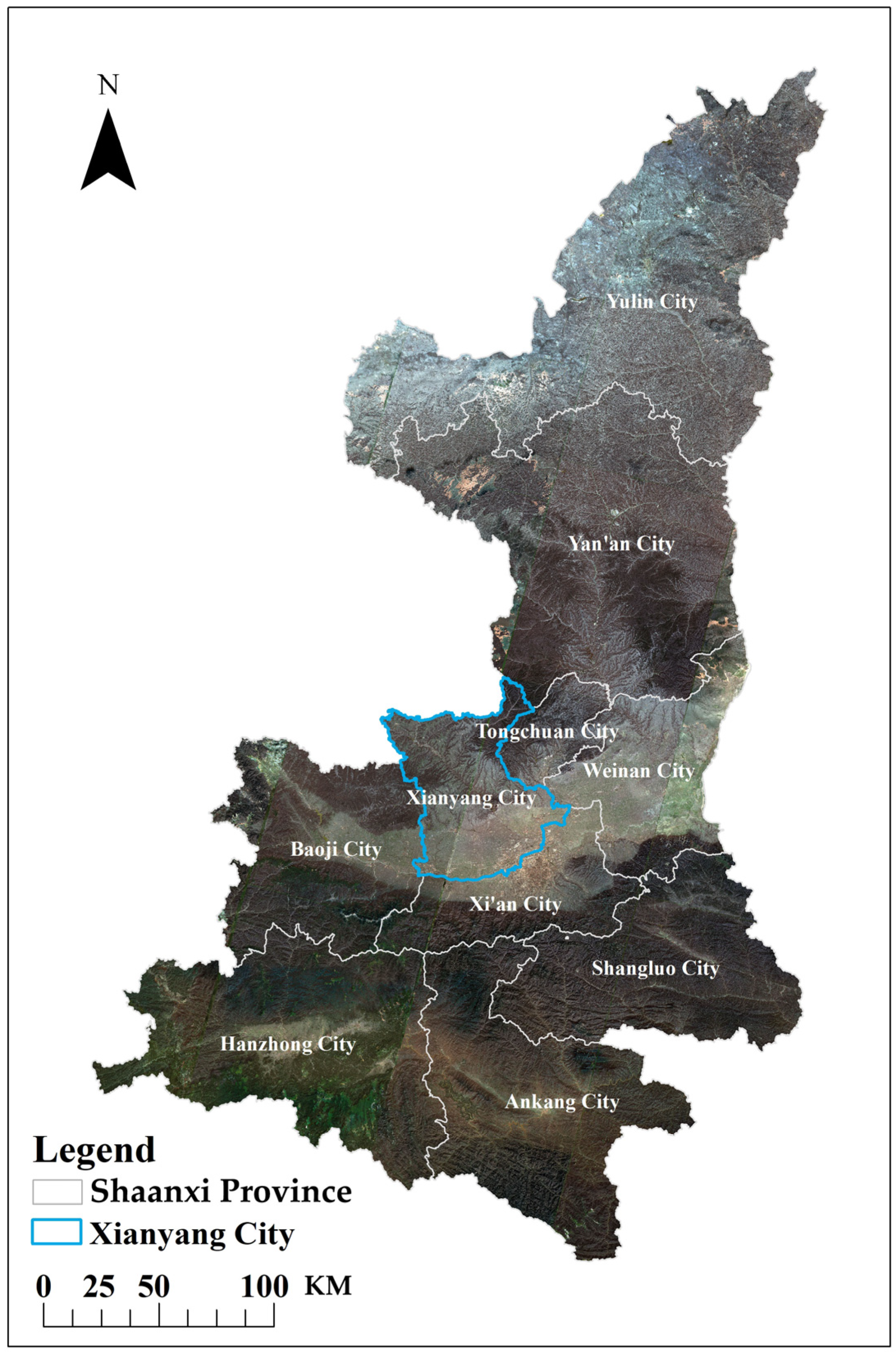

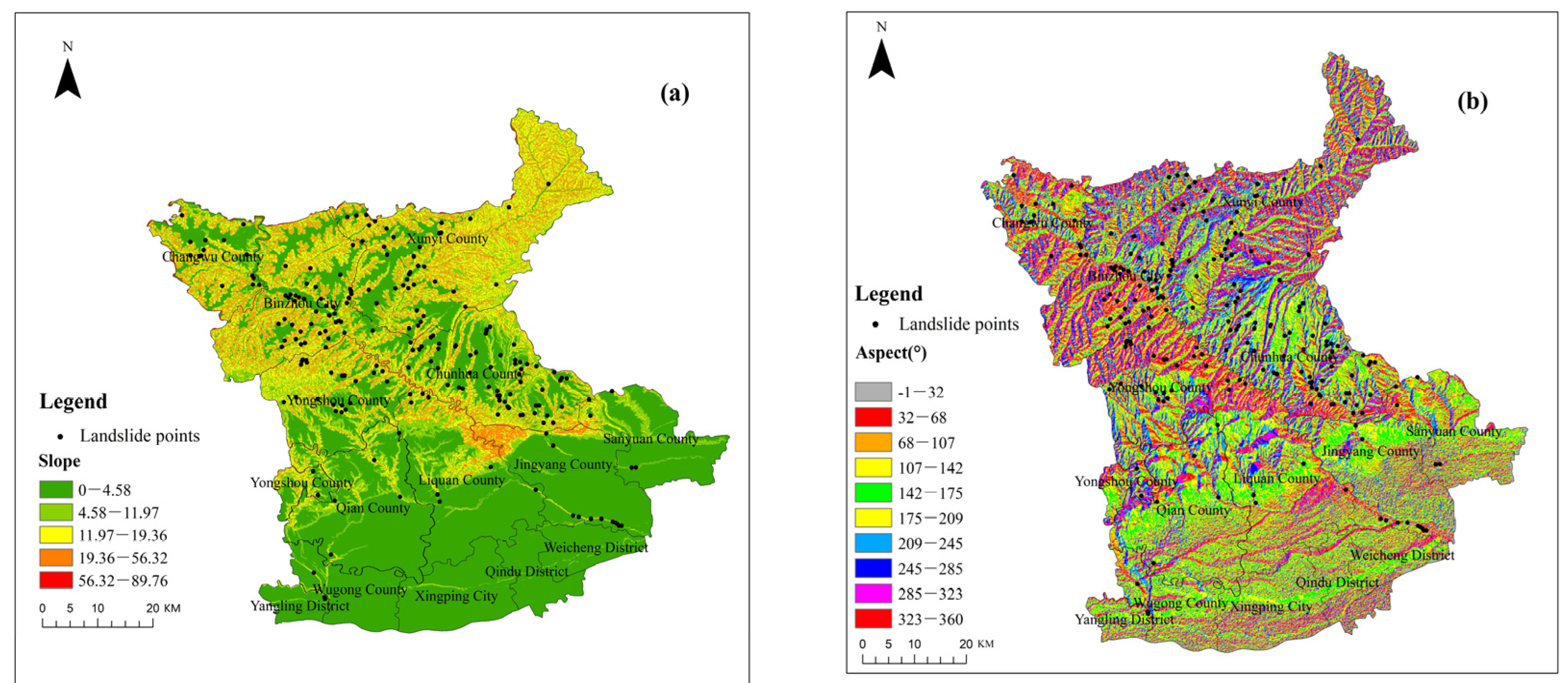
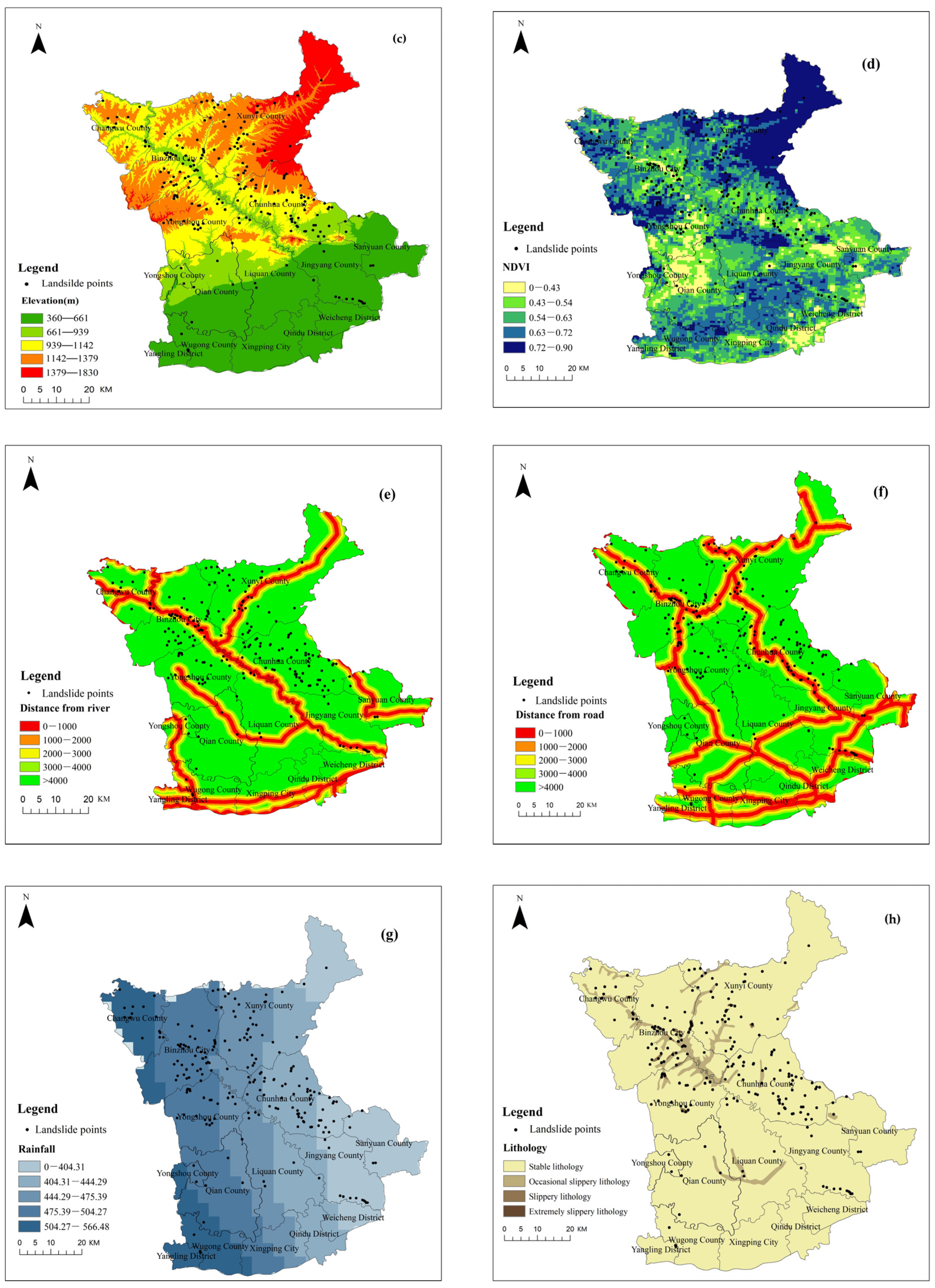
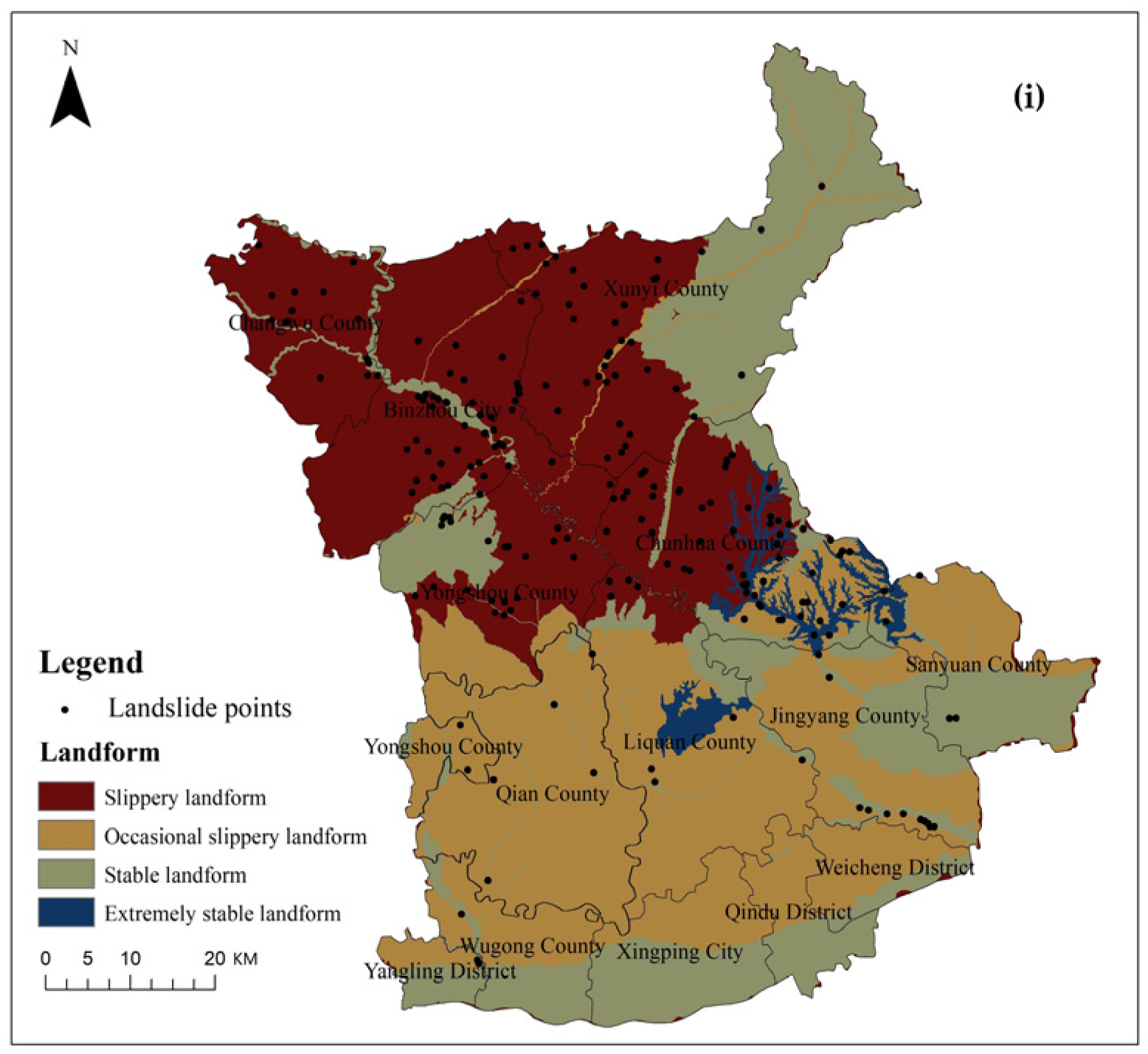

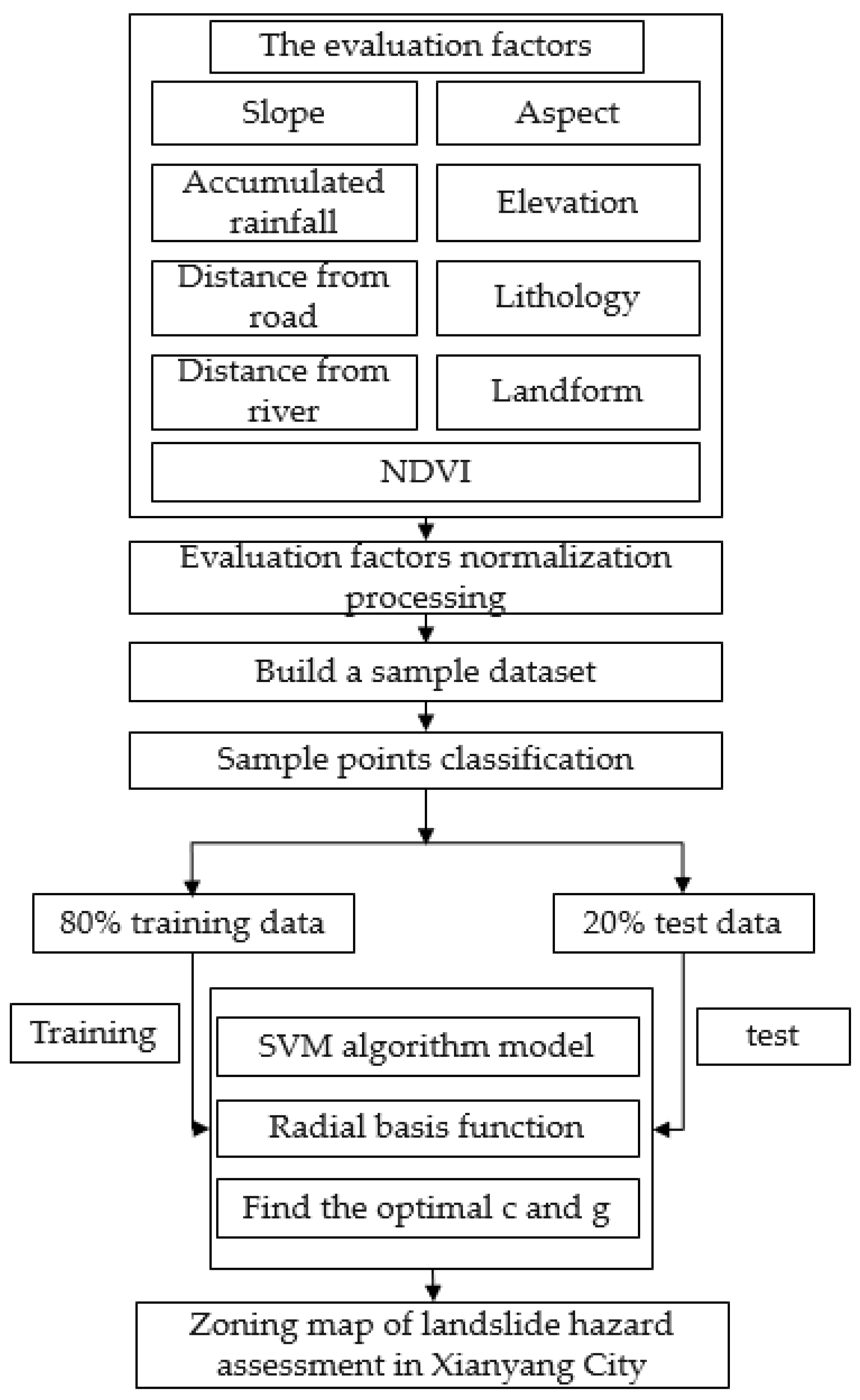

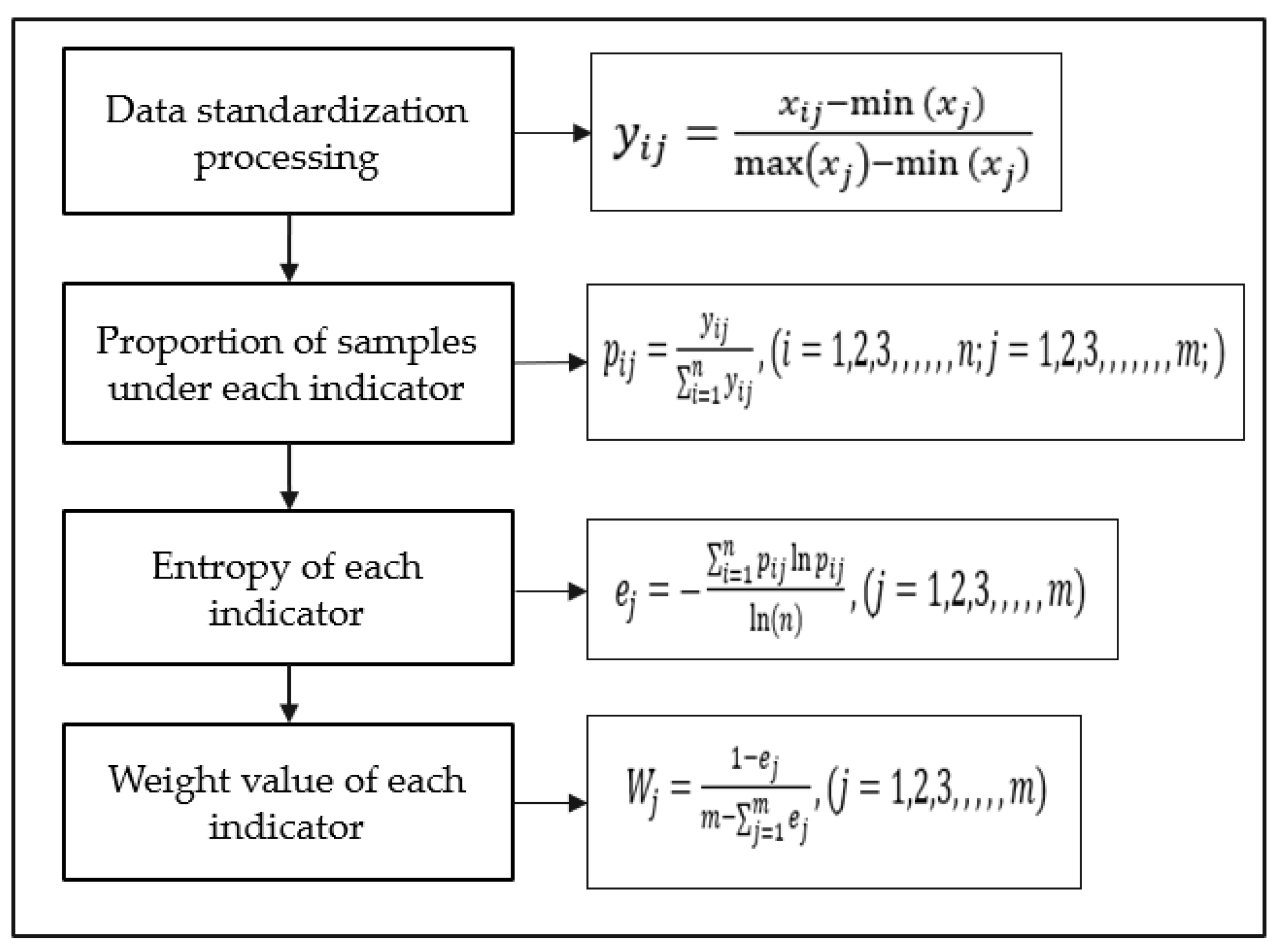

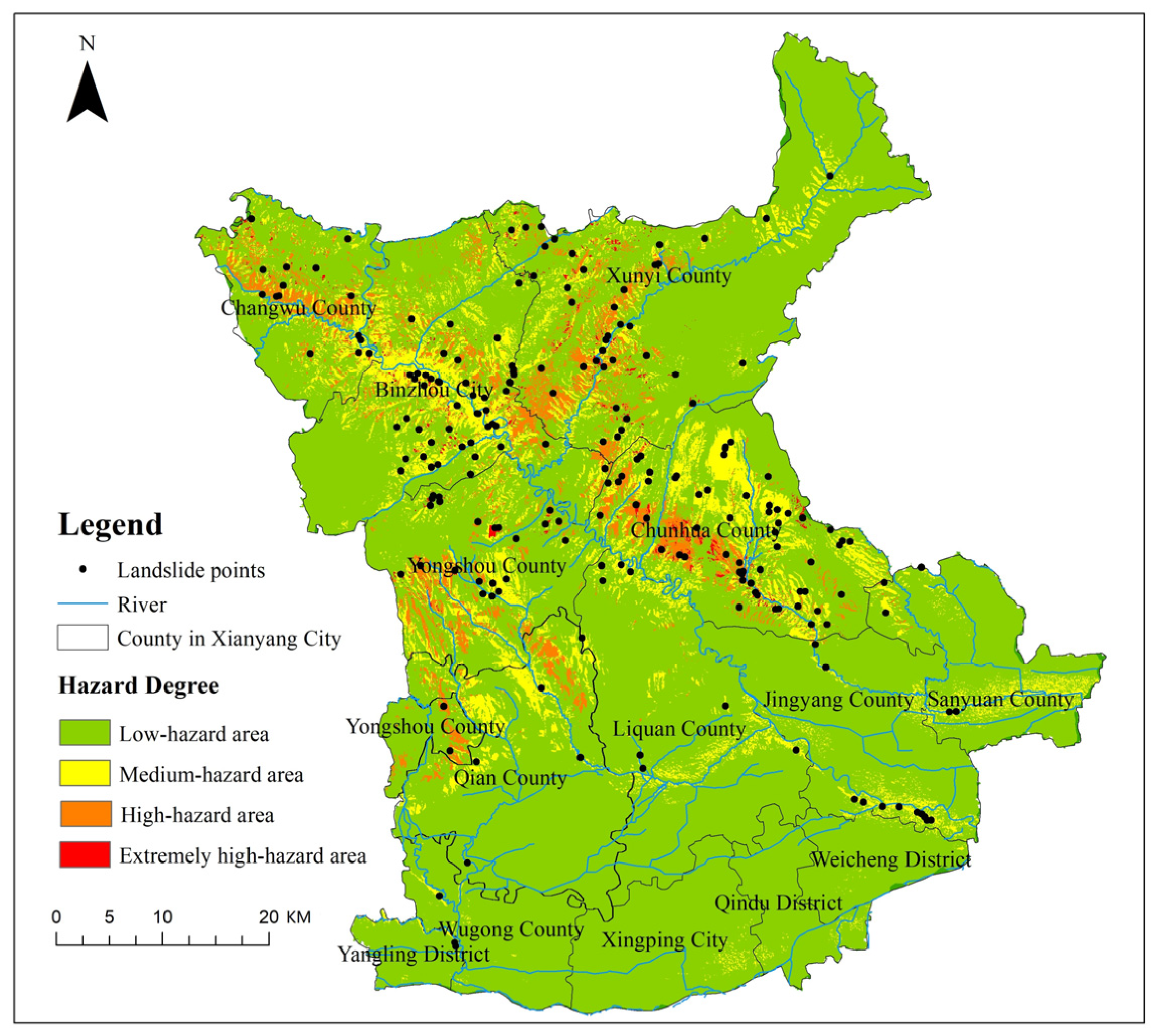
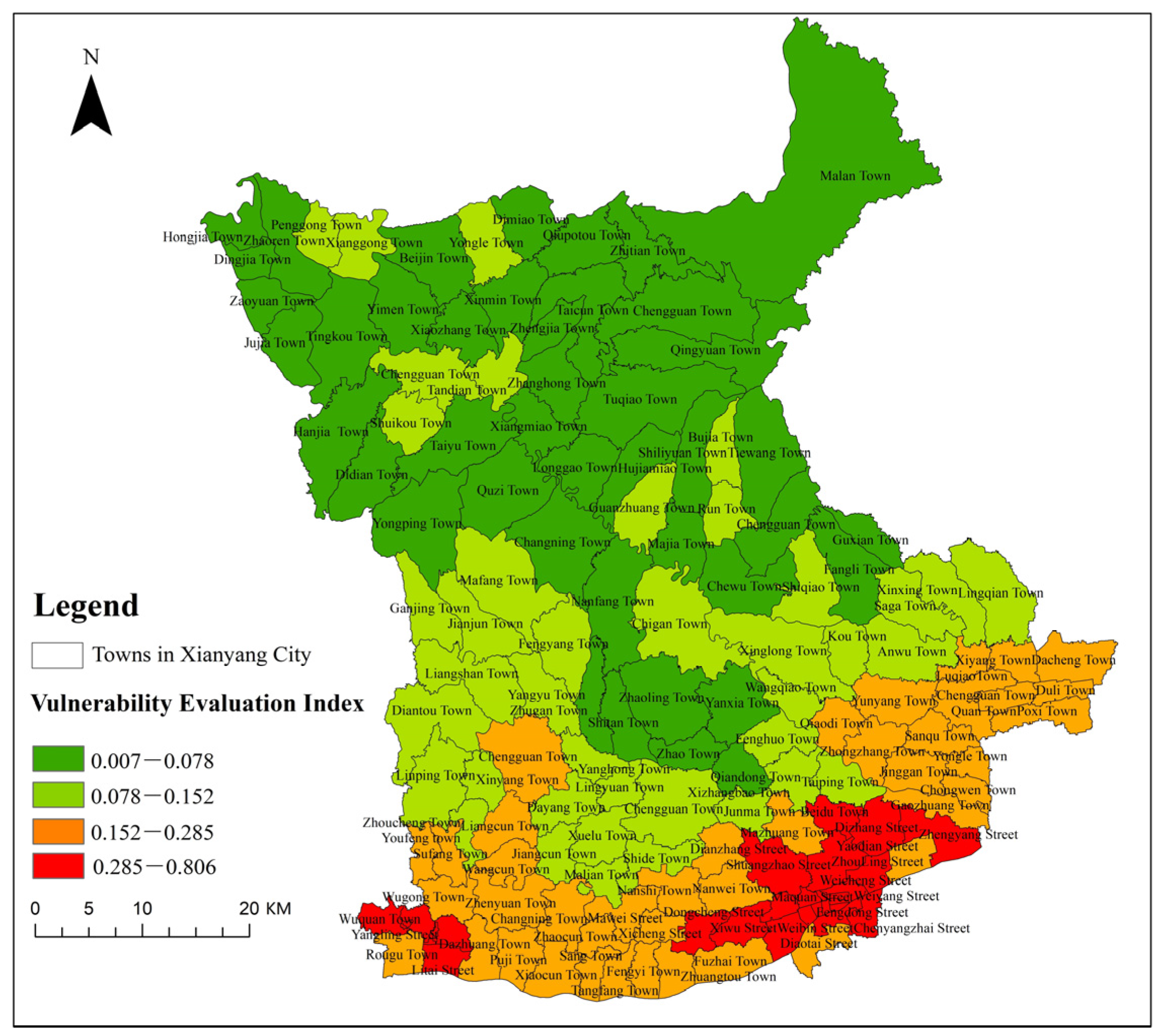
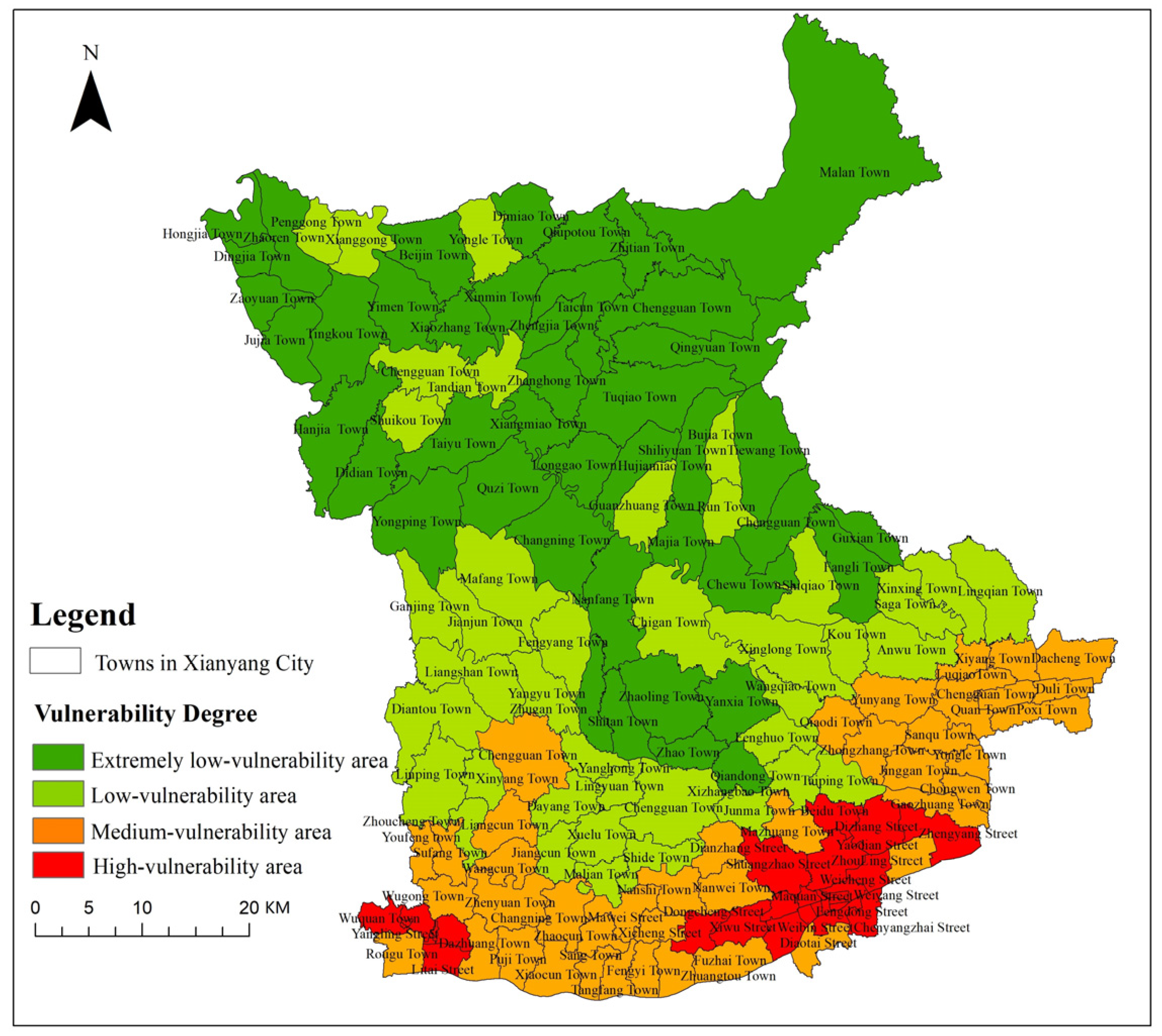

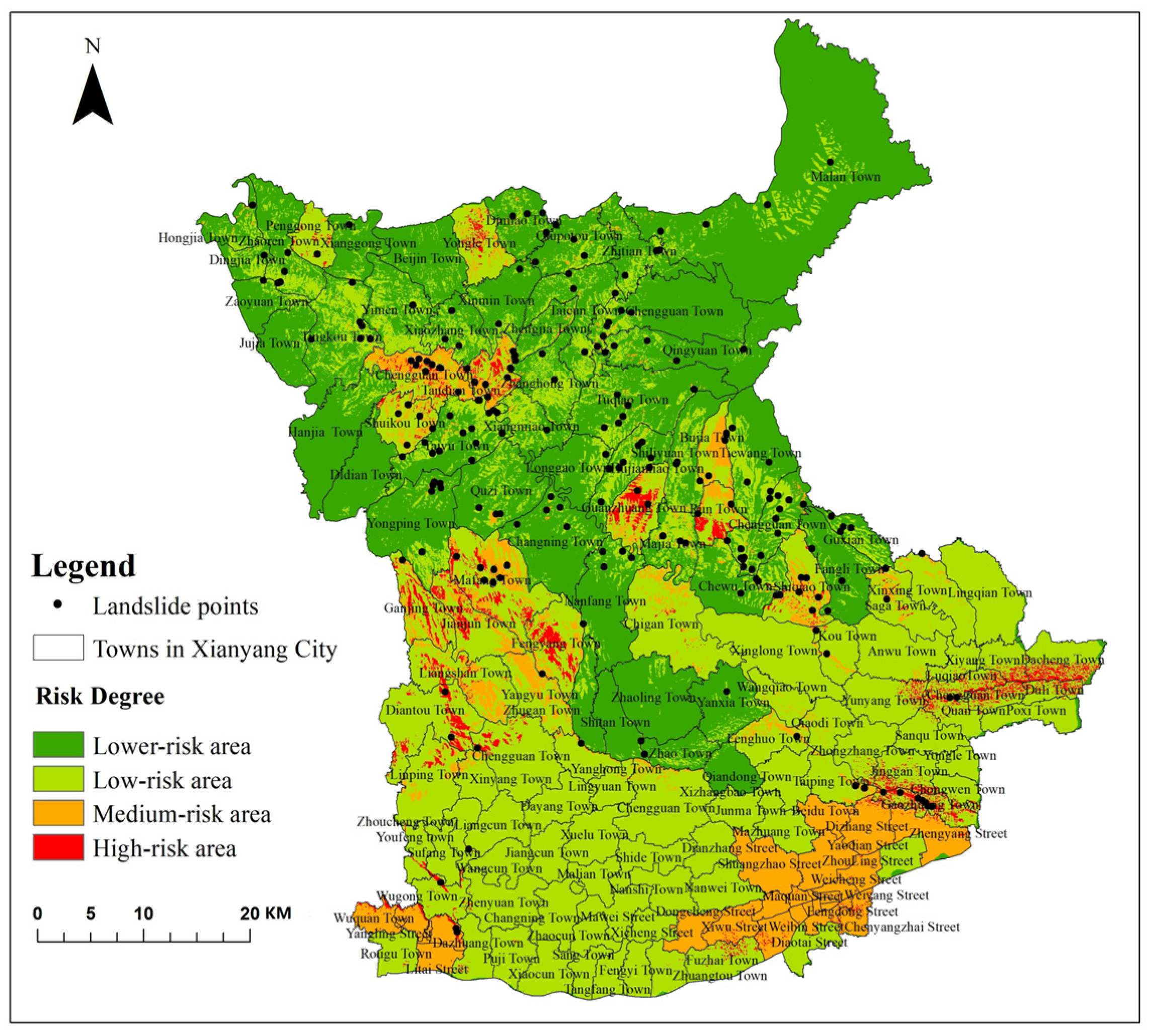
| Level | Landslide (104 m3) | Collapse (104 m3) | Mudslide (104 m3) | Ground Collapse (km2) |
|---|---|---|---|---|
| Extremely high hazard | ≥1000 | ≥100 | ≥50 | ≥10 |
| High hazard | 100~1000 | 10~100 | 20~50 | 1~10 |
| Medium hazard | 10~100 | 1~10 | 2~20 | 0.1~1 |
| Low hazard | <10 | <1 | <2 | <0.1 |
| Level | Death Toll (People) | Number of Threats (People) | Direct Economic Loss (Ten Thousand) | Potential Economic Loss (Ten Thousand) |
|---|---|---|---|---|
| Extremely high risk | ≥30 | ≥1000 | ≥1000 | ≥10,000 |
| High risk | 10~30 | 100~1000 | 500~1000 | 5000~10,000 |
| Medium risk | 3~10 | 10~100 | 100~500 | 500~5000 |
| Low risk | <3 | <10 | <100 | <500 |
| Standards | Meanings |
|---|---|
| 1 | When two factors are compared, they have the same importance |
| 3 | When two factors are compared, the former is slightly more important than the latter |
| 5 | When two factors are compared, the former is obviously more important than the latter |
| 7 | When two factors are compared, the former is more important than the latter |
| 9 | When two factors are compared, the former is extremely more important than the latter |
| 2,4,6,8 | The adjacent middle value of the above |
| 1/i (i = 1, 2…9) | The above situation is reversed |
| Disaster Intensity Level | Count (Piece) | Proportion (%) |
|---|---|---|
| Extremely high hazard | 2 | 0.314 |
| High hazard | 45 | 7.064 |
| Medium hazard | 106 | 16.641 |
| Low hazard | 484 | 75.981 |
| Types of Disaster | Extremely High Hazard | High Hazard | Medium Hazard | Low Hazard |
|---|---|---|---|---|
| Landslide | 2 | 27 | 67 | 119 |
| Collapse | 0 | 18 | 35 | 242 |
| Surface collapse | 0 | 0 | 4 | 36 |
| Mudslide | 0 | 0 | 0 | 3 |
| Ground fissure | 0 | 0 | 0 | 83 |
| Unstable slope | 0 | 0 | 0 | 1 |
| Dangerousness | Area (km2) | Proportion |
|---|---|---|
| Extremely low-hazard area | 8036.952 | 84.21% |
| Low-hazard area | 1008.186 | 10.56% |
| Medium-hazard area | 456.471 | 4.78% |
| High-hazard area | 41.991 | 0.44% |
| Evaluation Factor | Population Density | Road Density | Arable Land Density | GDP Density | CR | λmax |
|---|---|---|---|---|---|---|
| Weights | 0.5860 | 0.2418 | 0.1149 | 0.0573 | 0.0804 | 4.217 |
| Evaluation Factor | Population Density | Road Density | Arable Land Density | GDP Density |
|---|---|---|---|---|
| Weights | 0.2467 | 0.2649 | 0.0850 | 0.4033 |
| Evaluation Factor | Population Density | Road Density | Arable land Density | GDP Density |
|---|---|---|---|---|
| Comprehensive weights | 0.474703 | 0.24936 | 0.105094 | 0.170843 |
| Risk Zoning | Lower-Risk Area | Low-Risk Area | Medium-Risk Area | High-Risk Area |
|---|---|---|---|---|
| Value at risk | (0,1) | (1,3) | (3,4) | (4,9) |
| Degree of Risk | Area (km2) | Percentage |
|---|---|---|
| Lower-risk area | 3693.954 | 38.706% |
| Low-risk area | 4711.729 | 49.370% |
| Medium-risk area | 896.870 | 9.398% |
| High-risk area | 241.047 | 2.526% |
Publisher’s Note: MDPI stays neutral with regard to jurisdictional claims in published maps and institutional affiliations. |
© 2021 by the authors. Licensee MDPI, Basel, Switzerland. This article is an open access article distributed under the terms and conditions of the Creative Commons Attribution (CC BY) license (https://creativecommons.org/licenses/by/4.0/).
Share and Cite
Xu, S.; Zhang, M.; Ma, Y.; Liu, J.; Wang, Y.; Ma, X.; Chen, J. Multiclassification Method of Landslide Risk Assessment in Consideration of Disaster Levels: A Case Study of Xianyang City, Shaanxi Province. ISPRS Int. J. Geo-Inf. 2021, 10, 646. https://doi.org/10.3390/ijgi10100646
Xu S, Zhang M, Ma Y, Liu J, Wang Y, Ma X, Chen J. Multiclassification Method of Landslide Risk Assessment in Consideration of Disaster Levels: A Case Study of Xianyang City, Shaanxi Province. ISPRS International Journal of Geo-Information. 2021; 10(10):646. https://doi.org/10.3390/ijgi10100646
Chicago/Turabian StyleXu, Shenghua, Meng Zhang, Yu Ma, Jiping Liu, Yong Wang, Xinrui Ma, and Jie Chen. 2021. "Multiclassification Method of Landslide Risk Assessment in Consideration of Disaster Levels: A Case Study of Xianyang City, Shaanxi Province" ISPRS International Journal of Geo-Information 10, no. 10: 646. https://doi.org/10.3390/ijgi10100646
APA StyleXu, S., Zhang, M., Ma, Y., Liu, J., Wang, Y., Ma, X., & Chen, J. (2021). Multiclassification Method of Landslide Risk Assessment in Consideration of Disaster Levels: A Case Study of Xianyang City, Shaanxi Province. ISPRS International Journal of Geo-Information, 10(10), 646. https://doi.org/10.3390/ijgi10100646






